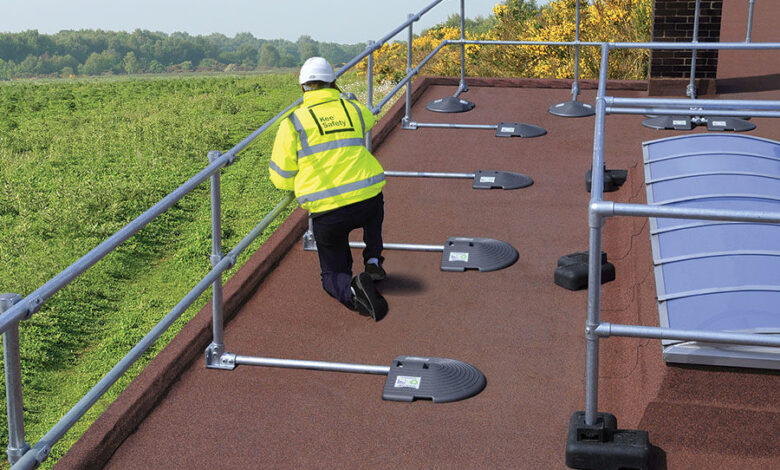Choose the Right Fall Protection Guardrail for Your Job Site

Safety is the most critical consideration while working on construction sites or anywhere people are exposed to heights. Guardrails are one of the most effective safety measures. Fall Protection Guardrail prevent workers from slipping from edges such as roofs, platforms, or scaffolding. Choosing the appropriate guardrail for your job site is critical since it reduces the likelihood of accidents and injuries. Further, a guardrail is a safety barrier on the edge of a platform, rooftop, or other elevated surface to keep people from falling. These barriers are commonly utilized at construction sites, industries, warehouses, and roofs. Guardrails are an essential component of fall protection systems because they act as a physical barrier, preventing accidents before they occur.
Guardrails are required at many job locations. For example, a rooftop may require a guardrail that can endure severe winds. Still, a warehouse may require a moveable guardrail that allows for easy workplace changes. Knowing your individual job site requirements can help you make the best decision.
Types of Guardrails
Ensure the material you use is robust enough to endure the circumstances on your project site. For example, outdoor job sites exposed to harsh weather may require guardrails that withstand rust and corrosion, but inside ones may not. Fall Protection guardrail come in various styles, each tailored to a certain location or activity. Let’s look at the most prevalent types.
Permanent Guardrails
Permanent guardrails are erected for long-term usage and are commonly seen on rooftops or other high-risk sites where workers routinely operate. These guardrails are set in situ and are highly sturdy and enduring. Permanent guardrails may be best if your job site requires continuing protection. They offer dependable, constant fall prevention for employees.
Temporary Guardrails
Temporary guardrails are intended to be shifted as needed. They are commonly utilized in construction projects where job sites change over time. These guardrails are simple to install and remove, making them ideal for short-term applications. If your job site constantly shifts, portable guardrails provide flexibility and protection.
Portable Guardrails
Portable guardrails are comparable to temporary guardrails, but they provide more flexibility. These guardrails are light and easy to transport from one area to another. They are perfect for job locations requiring speedy installation and removal of safety obstacles. Although they are less sturdy than permanent guardrails, they provide enough protection. They may be tailored to specific regions of the site.
Roof Guardrails
Roof guardrails are developed mainly for use in rooftop work settings. They are designed to resist extreme weather and give stability on uneven surfaces. If your employees need to do duties on the roof, a roof-specific guardrail is essential. These guardrails often have non-penetrating bases, which means they will not damage the roof structure when placed.
Factors to Consider When Selecting a Guardrail
Proper maintenance increases the life of the guardrail and ensures that it remains safe for workers. This is especially crucial for permanent guardrails exposed to the elements or requiring much use. So, choosing the appropriate guardrail for your job site is determined by some criteria. US Fall Protection will assist you in deciding which type of guardrail is most suited to your requirements. Here are some essential aspects to consider:
Jobsite Environment
The atmosphere of your job site is one of the most crucial aspects to consider when selecting a fall protection guardrail. A temporary or portable guardrail, such as a factory or warehouse, is enough if your job location is indoors. However, suppose your site is outdoors and exposed to the elements, such as on a roof. In that case, you will want a more durable, weather-resistant guardrail. Consider what surface the guardrail will be built on. For example, if you’re placing a guardrail on a roof, ensure that the bases are non-penetrating so they don’t harm the roof. You may require a bolted-down guardrail for further stability if it is on concrete or steel.
Durability and Material
The longevity of the guardrail is heavily influenced by the material used. Steel, aluminum, and, on occasion, plastic or composite materials are commonly used. Steel guardrails are highly durable and can withstand severe impacts, making them appropriate for high-risk settings such as construction sites. Aluminum guardrails are lightweight yet sturdy, ideal for temporary or portable installations.
Easy Installation and Mobility
For job sites that change locations regularly, having a simple guardrail system to build and relocate is essential. Temporary and portable guardrails are meant to be easily constructed and do not require any particular tools. These guardrails save time and effort in ensuring safety while moving job locations. Permanent guardrails, while safer, require more effort to build. These methods frequently require drilling and securing the guardrail, making them less adaptable for movable installations.
Conformance to Safety Standards
When selecting guardrails, ensure that they meet safety requirements and laws. In several nations, guardrails must fulfill specified safety standards. For example, the Occupational Safety and Health Administration (OSHA) establishes guardrail construction and installation criteria in the United States. Before purchasing and installing a guardrail, ensure it satisfies the appropriate safety requirements. Using non-compliant guardrails might lead to penalties or accidents. Always search for approved guardrails that comply with local standards.
The Advantages of Guardrails as Fall Protection Solutions
Guardrails are among the best fall prevention solutions because they create a physical barrier between workers and possible risks. Guardrails, unlike other safety precautions like harnesses and netting, prevent workers from falling in the first place. This makes them the favored choice for many job locations where fall prevention is a top issue.
In addition, fall protection guardrail are a passive safety solution, which means that workers do not need to do anything to utilize them. They are continuously there, offering continuous protection without requiring workers to make any effort. It makes them highly dependable Fall Protection Solutions. Maintaining and inspecting guardrails Regular maintenance and inspection are necessary to keep guardrails in good working order. Even the most durable fall protection guardrail can get worn or destroyed over time. Check the guardrails on a regular basis for signs of corrosion, wear, and deterioration. If any pieces of the guardrail are loose or bent, they should be fixed or replaced right away.





